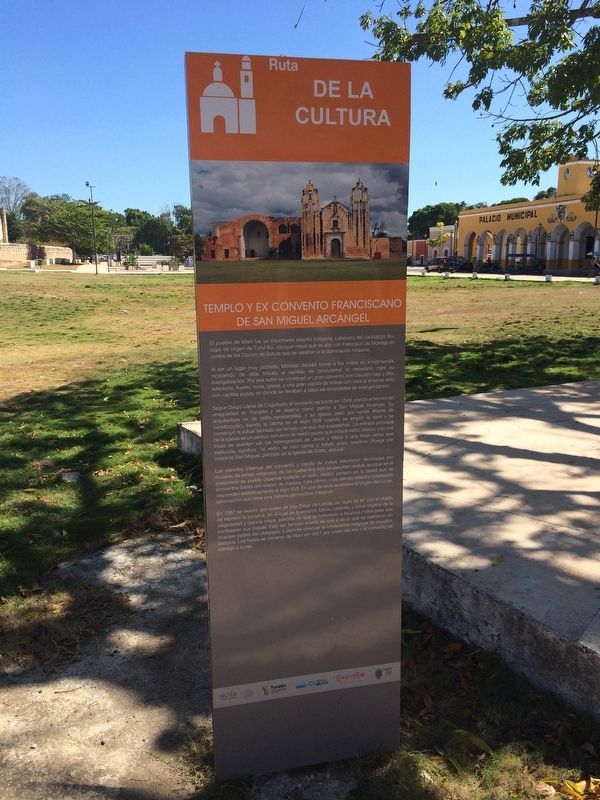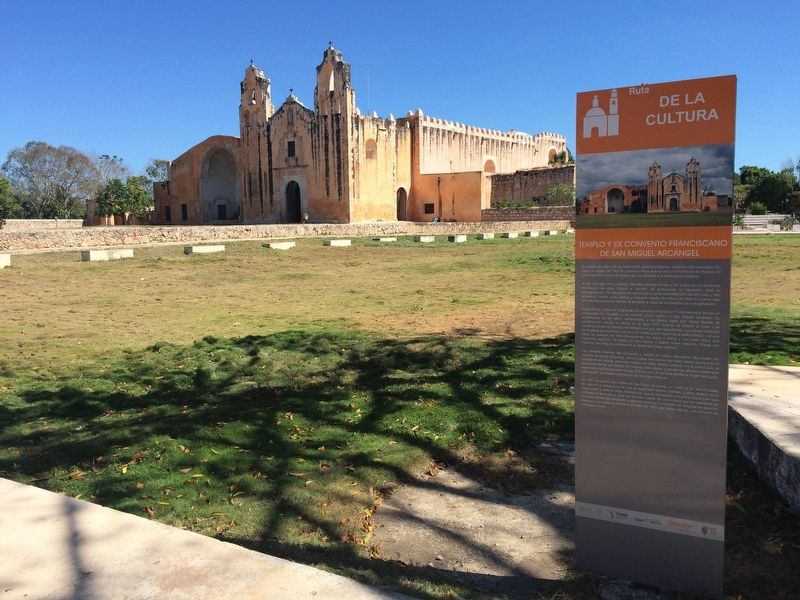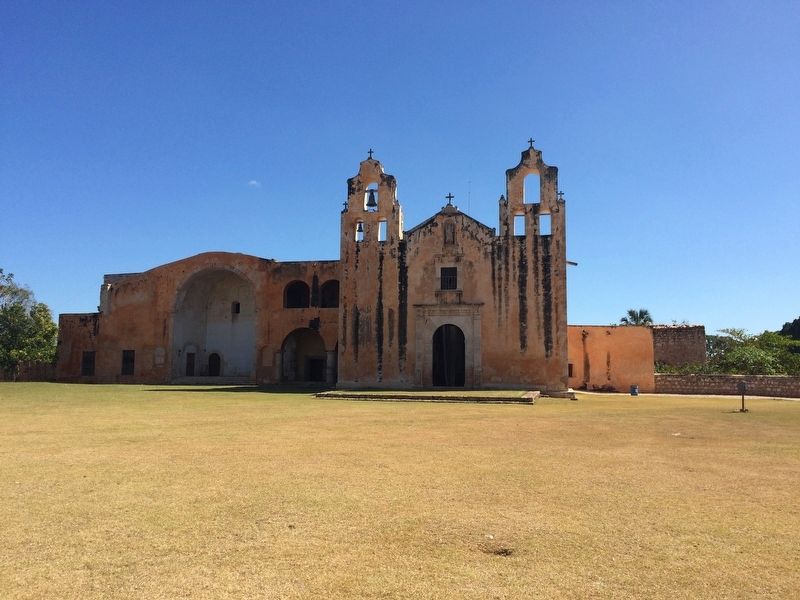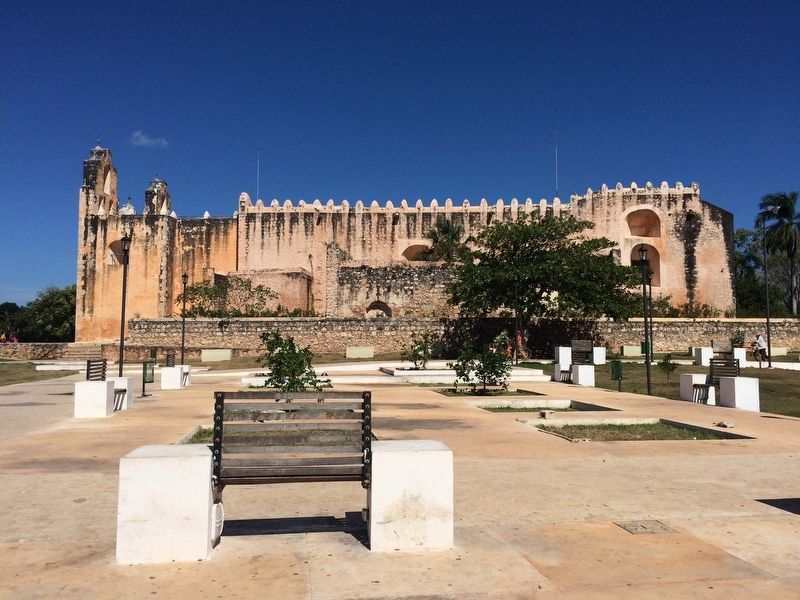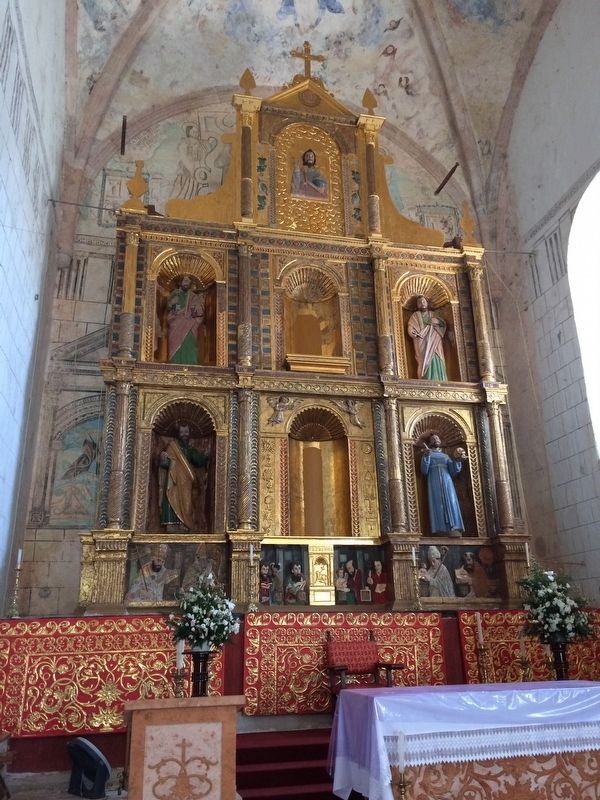Maní, Yucatán, Mexico — The Southeast (Yucatan Peninsula)
The Franciscan Temple and Ex-Convent of San Miguel Arcángel
Ruta de la Cultura / A Cultural Route
Inscription.
Templo y Ex Convento Franciscano de San Miguel Arcángel
El pueblo de Maní fue un importante asiento indígena, cabecera del cacicazgo Xiu, lugar de origen de Tutul Xiul, cacique maya que se alió con Francisco de Montejo en contra de los Cocom de Sotuta que se resistían a la dominación hispana.
Al ser un lugar muy poblado, Montejo decidió tomar a los indios en encomienda, recibiendo de ellos tributo, a cambio de procurarles lo necesario para su evangelización. Por esa razón se construyó un gran convento con claustro bajo y alto refectorio, huerto, noria, iglesia, y una gran capilla de indios con vista al enorme atrio con capillas pozas, en donde se llevaban a cabo las actividades de evangelización.
Según Diego López de Cogullodo, el convento se fundó en 1549, siendo el tercero en antigüedad en Yucatán y se destinó como patrón a San Miguel Arcángel. Su arquitectura se de estilo renacentista, y su iglesia pasó por varias etapas de construcción, siendo la última en el siglo XVIII cuando se amplió la nave y se construyó la actual fachada del templo con sus dos espadañas. La entrada principal de la iglesia es un pórtico con arco de medio punto que imita al estilo clásico, y en sus frisos se pueden ver los monogramas de Jesús y María y una frase latina que traducida significa: “el verbo se hizo carne, y habitó entre nosotros. Ruega por nosotros San Miguel, príncipe de la Iglesia de Cristo, aleluya”
Las paredes internas del convento y capilla de indios estuvieron decoradas por murales de temas religiosos, de los cuales hoy sólo se perciben restos, aunque en el presbiterio se puede observar todavía un bello retablo pintado en la pared que se encuentra detrás del retablo de madera. Este último, y los demás retablos colaterales responden estilísticamente al siglo XVII. En uno de esos se exhibe la Virgen del Lunar, advocación que tiene una historia de muchos milagros.
En 1567 se realizó, por orden de fray Diego de Landa, un “auto de fe” con el objeto de reprimir la idolatría, en el cual se quemaron ídolos, códices, y otros objetos de la religiosidad y ciencia maya, además de que se torturaron a muchos indios para que confesaron sus culpas. Este tan famoso evento se une a otros que se realizaron en diversas partes del obispado, y permite conocer la intolerancia religiosa de aguellos tiempos. Los frailes se retiraron de Maní en 1821 por orden del rey, y el convento se entregó a curas.
English translation:
The Franciscan Temple and Ex-Convent of San Miguel Arcángel
The town of Maní was an important indigenous town. It was the capital of the Xiu chiefdom and the place of origin of Tutul Xiul, a Maya chief that allied with Francisco de Montejo against the
Cocom de Sotuta that resisted Spanish domination. Montejo decided to take the Indians under his control in a tribute system known as the “encomienda” system, receiving valuable goods from the town in exchange for providing them with the materials necessary for their evangelization. For this reason, a large convent was built with a low cloister and high refectory, orchard, well, church, and a large Indian chapel overlooking the enormous atrium with chapels, where evangelization activities were carried out.
According to Diego López de Cogullodo, the convent was founded in 1549, being the third oldest in Yucatán. It was dedicated with San Miguel Arcángel as its patron saint. Its architecture belongs to the Renaissance style. The church went through several stages of construction, with the last one coming in the 18th century when the main body of the church was extended and the present facade of the temple with its two steeples was constructed. The main entrance of the church is a portico with a semicircular arch that imitates the Classic style, and in its friezes you can see the initials of the names of Jesus and Mary, together with a Latin phrase that translated means: "the word became flesh, and lived among us. Pray for us Saint Michael, prince of the Church of Christ, hallelujah"
The interior walls of the convent and the chapel of Indians were decorated by murals
with religious themes, of which today only a few remains can be seen. In the presbytery it is possible to still see a beautiful altarpiece painted on the wall behind the wooden altarpiece. The wooden altarpiece and the other associated altarpieces belong stylistically to the seventeenth century. In one of these is exhibited the Virgin of the Lunar, an image that has a history of many miracles.
In 1567, on the orders of Fray Diego de Landa, an "auto da fe" (act of faith) was carried out in order to suppress idolatry, in which supposed idols, codices, and other objects of Maya religiosity and science were burned. In addition, many Indians were tortured so that they confessed their not having converted to Christianity. This famous event joins others that took place in various parts of the bishopric, and are incredible examples of the extreme religious intolerance of the times. The friars retired from Mani in 1821 on the orders of the Spanish king and the convent was given to priests.
Topics. This historical marker is listed in these topic lists: Architecture • Churches & Religion • Disasters • Fraternal or Sororal Organizations • Native Americans • Women. A significant historical year for this entry is 1549.
Location. 20° 23.293′ N, 89° 23.603′ W. Marker is in Maní, Yucatán. Marker
is at the intersection of Calle 28 and Calle 25, on the right when traveling north on Calle 28. The marker is underneath a large ceiba tree to the west of the temple and ex-convent. Touch for map. Marker is in this post office area: Maní YU 97850, Mexico. Touch for directions.
Credits. This page was last revised on January 4, 2023. It was originally submitted on March 10, 2017, by J. Makali Bruton of Accra, Ghana. This page has been viewed 212 times since then and 17 times this year. Photos: 1, 2. submitted on March 10, 2017, by J. Makali Bruton of Accra, Ghana. 3, 4, 5. submitted on March 11, 2017, by J. Makali Bruton of Accra, Ghana.
